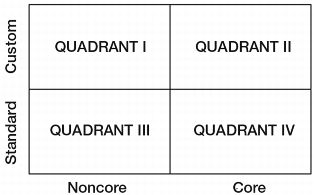A quadrant approach classifies all Postal Service purchases into four categories, depending on their impact on the Postal Service core competencies (noncore versus core) and complexities (standard versus custom). Because a preliminary investment recovery plan outlines what to do at the end of the project lifespan and is developed before the completion of a purchase, the quadrant approach should be leveraged by the client to guide the decision to recycle, reallocate, resell, remarket, return, remanufacture, or remove, as shown in Figure 2.7.
Figure 2.7
Four Quadrants

Surplus and idle items in this quadrant will be recycled or reallocated and do not need to be addressed by proposals because both are in-house activities. The strategic approach regarding Quadrant I calls for supply continuity, and these items should be used multiple times.
Surplus and idle items from Quadrant II will be recycled, reallocated, resold, remarketed, or returned. Remarketing and return require supplier collaboration and should be addressed by proposals. These items are vital to the Postal Service’s operations and therefore may necessitate recycling or reallocation. They are also vital in the market, are of high value, and therefore can warrant reselling, remarketing, or return. Note: These items are specific to the client’s goals and strategies, but have been customized to the client’s business function, so reselling or remarketing may be compromised.
Surplus and idle items in Quadrant III will be recycled, reallocated, resold, or removed. Removal requires supplier collaboration and therefore should be addressed by proposals. These items have many sources and many options and provide low value to the end client. Most of these items (e.g., office supplies) should be recycled, reallocated, or removed. However, certain items are desired by external organizations, have a resale value, and should be resold (e.g., IT).
Surplus and idle items in Quadrant IV have many alternatives and many sources and are readily available in the marketplace. Items of this standard nature can have various functions and therefore can be useful both internally and externally. These items will be recycled, reallocated, resold, remarketed, returned, remanufactured, or removed and should be addressed by proposals because these disposal options require supplier collaboration.
